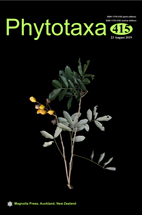Abstract
Acanthopsis is a genus endemic to southern Namibia and southwestern South Africa. Until recently the taxonomy of the group was poorly understood. As a result of a new taxonomic framework (recognising 20 species), the risk of extinction of each taxon could be reassessed and updated. This contribution presents an overview of the distribution and conservation status of the species, as well as the patterns and possible processes involved in the phytogeography of the genus. Specimen localities for all examined specimens were georeferenced and these values were used for mapping and conservation assessments. Phylogenetic relationships within Acanthopsis were studied by using sequence data from the following six gene regions: nrITS, matK, rbcL, rps16, rpl32-trnL and trnS-trnG-trnG. The group appears to have diversified in the arid mountainous semi-desert of the Richtersveld, Northern Cape, South Africa, with the vast majority (96%) of Acanthopsis taxa endemic or near-endemic to the Succulent Karoo Region (more or less congruent with the Succulent Karoo Biome). Twenty of the 23 taxa are range-restricted and have an Extent of Occurrence ≤10000 km2, with at least eight of these known from only one or two subpopulations each. Fourteen (61%) of the taxa are Red Listed as Least Concern, while 39% are Red Listed as Threatened (Vulnerable, Endangered and Critically Endangered)—mainly as a result of habitat loss due to overgrazing and trampling by domestic livestock. Although the distribution ranges of most members of Acanthopsis coincide with protected areas, the effectiveness of conservation in these regions is questionable as some protected areas are prone to overgrazing and trampling by domestic livestock. The lack of phylogenetic resolution, complex taxonomy and the high numbers of range-restricted and habitat-specific species implies recent speciation in Acanthopsis due to topography, ecological gradients and climatic conditions prevailing in the arid northwestern parts of South Africa’s Northern Cape and adjacent arid parts of southern Namibia.

